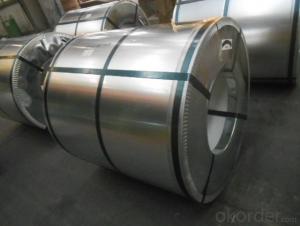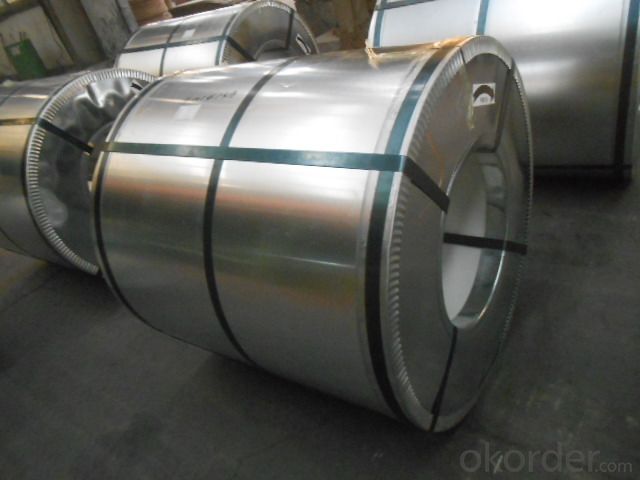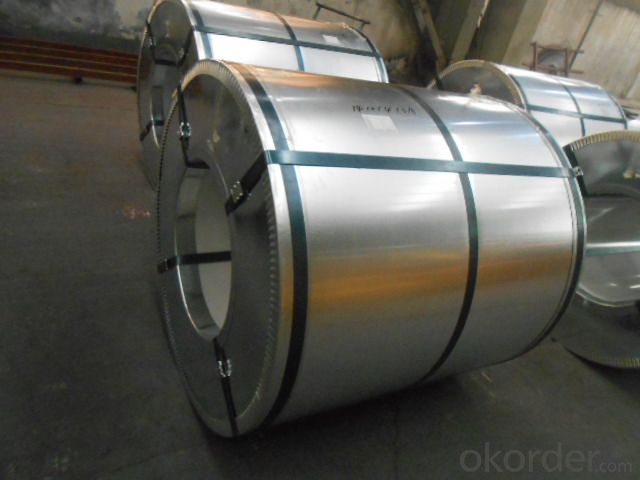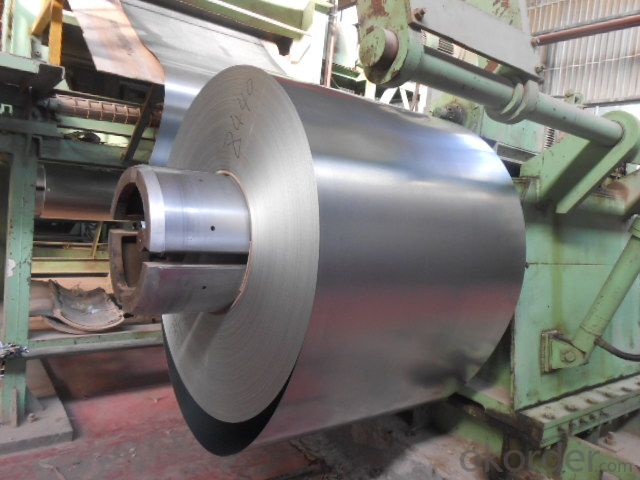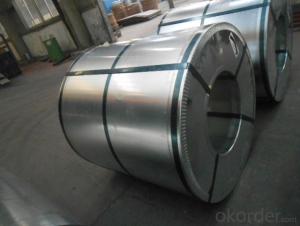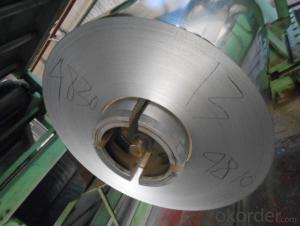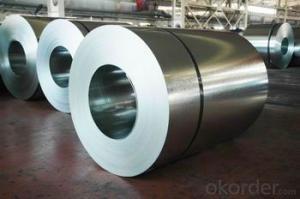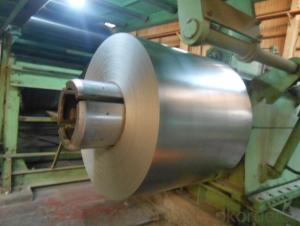Hot-dipped Galvanized Steel Coil In coil
- Loading Port:
- Tianjin
- Payment Terms:
- TT OR LC
- Min Order Qty:
- 25 m.t.
- Supply Capability:
- 2000 m.t./month
OKorder Service Pledge
OKorder Financial Service
You Might Also Like
Galvanized Steel Coil gets coated in layers of zinc because rust won't attack this protective metal. The most external layer is all zinc, but successive layers are a mixture of zinc and iron, with an interior of pure steel. These multiple layers are responsible for the amazing property of the metal to withstand corrosion-inducing circumstances. Zinc also protects the steel by acting as a "sacrificial layer." If rust does take hold on the surface of Galvanized Steel Coil, the zinc will get corroded first. This allows the zinc that is spread over the breach or scratch to prevent rust from reaching the steel. For countless outdoor, marine, or industrial applications, Galvanized Steel Coil is an essential fabrication component.
Superiority
1. Good Resistance to Corrosion
2. Qualified Processing Machinability
3. High Thermal Resistance
4. Excellent Reflectivity
5. Inexpensive and effective enough
6. Can be recycled and reused multiple times
STEEL GRADE & STANDARD:JIS G3302 SGCC
ZINC COATING MASS:Z09
SPANGLE:REGULAR SPANGLE
SURFACE TREATMENT:CHROMATED,UNOILED,NONSKINPASSED
SIZE:0.58*1200MM
COIL ID:508MM
COIL WEIGHT:4-7MT
- Q: What is the weight of a standard steel coil?
- The weight of a standard steel coil can vary, but on average, it ranges from 10 to 20 tons.
- Q: How many inches of steel can an AK47 using 7.62x39mm rounds penetrate through?
- It can't go through inches. It can go through up to 1/4 of an inch of plate steel but not much more. An M-16 can go through it as well and has less powder behind it but the 7.62X39 is a fat round and it takes a little more to get it through.
- Q: What are the different types of steel coil treatments?
- There are several types of steel coil treatments, including pickling, oiling, and galvanizing. Pickling involves immersing the steel coil in an acid bath to remove impurities and scale, resulting in a clean surface. Oiling is the process of applying a thin film of oil to the coil to prevent corrosion during storage and transportation. Galvanizing is a treatment where a layer of zinc is applied to the steel coil, providing excellent protection against corrosion.
- Q: How are steel coils annealed for improved properties?
- Steel coils are annealed for improved properties by heating them to a specific temperature and holding them at that temperature for a certain period of time. This process allows the steel to undergo recrystallization, which helps relieve internal stresses and improve its ductility and toughness. After annealing, the steel coils are slowly cooled, further enhancing their mechanical properties.
- Q: How are steel coils used in the production of industrial machinery?
- Steel coils are used in the production of industrial machinery as they provide a strong and durable material for various components. These coils are often shaped and cut to specific sizes to create parts such as gears, shafts, and frames, which are essential for the functioning of machinery. The high strength and flexibility of steel coils make them ideal for withstanding heavy loads and harsh operating conditions, ensuring the reliability and longevity of industrial machinery.
- Q: What's the best way to clean granite countertops and stainless steel appliances? My countertops especially always look dull and streaky. Thanks!!!!!!!
- Stainless steel kitchen appliances look best when they're clean and shiny. To clean tough stains and cooking grease, and give them a dazzling shine, try the same detergent you would use when washing the dishes. One formulated to cut grease works especially well.This also works well for general kitchen cleaning.Waterless hand soap also works great as a polish, simply rub on, and polish - no rinsing. :) Don't use an ordinary kitchen cleaning product to clean granite. The newest technology uses peroxide and detergents to penetrate soiled areas. Simply spray a product such as Bio-OX Citrus Concentrate on the soiled area, allow it to penetrate for a few minutes, then wipe clean. Baking soda can be sprinkled on for a more abrasive cleaning action. Repeat if necessary. Granite can also be cleaned using warm, sudsy water (a mild detergent such as a grease cutting dish detergent or laundry detergent is fine) or a solution of borax and water. Thoroughly rinse and buff dry. To remove stains from granite, make a paste of baking soda and hydrogen peroxide or baking soda and Bio-OX Citrus Concentrate and cover the stain with the paste. Cover the paste with a damp cloth, leave overnight, then wet down and scrub with a nonmetallic scrubbing pad. Rinse thoroughly with clean water. Wipe up any spills as they happen so they don't soak in, and always dry coutertops after washing the dishes.
- Q: What are the different methods of roll forming steel coils?
- There are several different methods of roll forming steel coils, each with its own unique characteristics and applications. Some of the most common methods include: 1. Traditional Roll Forming: This is the most widely used method and involves passing a continuous strip of steel through a series of rollers to gradually shape it into the desired profile. This method provides high precision and repeatability, making it suitable for producing complex shapes and profiles. 2. Pre-Punch and Cut: In this method, the steel strip is pre-punched with holes or slots before it is roll formed. This allows for easier cutting and shaping of the material during the forming process. Pre-punching and cutting can improve efficiency and reduce waste in certain applications. 3. Post-Punch and Cut: This method is similar to pre-punching and cutting, but the holes or slots are added after the roll forming process. This allows for more flexibility in creating custom shapes and designs, as the holes can be placed precisely where needed. 4. Post-Forming: In some cases, the steel strip may be first roll formed into a basic shape or profile and then further manipulated or formed after the initial roll forming process. This method allows for additional customization and can be used to create more complex geometries. 5. Progressive Roll Forming: This method involves passing the steel strip through a series of rollers in a continuous process, with each roller gradually adding a specific feature or forming a particular part of the final profile. Progressive roll forming is commonly used for long, continuous profiles with repetitive shapes. 6. Incremental Roll Forming: In this method, the steel strip is incrementally formed by a series of small movements of the rollers. This allows for greater flexibility in shaping complex profiles and can be particularly useful for producing prototypes or low-volume production runs. Overall, the choice of roll forming method depends on the specific requirements of the application, such as the desired shape, complexity, precision, and production volume. Each method offers its own advantages and limitations, and manufacturers often select the most appropriate method based on these factors.
- Q: How are steel coils used in the manufacturing of power generation equipment?
- Steel coils are used in the manufacturing of power generation equipment as they are shaped and formed into various components such as turbine blades, casings, and structural supports. The strength and durability of steel make it suitable for withstanding high temperatures and pressures, ensuring the reliability and longevity of the equipment. Additionally, steel coils are often used in the production of electrical transformers and generator cores, providing a magnetic circuit that efficiently converts mechanical energy into electrical energy.
- Q: is there a type of steel that is stronger or does the rail represent the top of the line?
- No, train tracks are not made of the strongest steel. Actually, I believe they are made from a rather mild steel, maybe a high-carbon steel in the curves, but no means is this top of the line. Probably the best all around high strength steel, if you count hardness, tensile strength, shear, and yield is Eglin steel. It has a yield of about 245,000 psi an ultimate strength of around 293,000 psi a harness of 45.6 and an impact of about 75 joules. It's cheaper than exotic alloys, you can build aircraft with the stuff because weight isn't an issue and it's plenty strong enough. Its also very strong even in extreme temperatures. The material has a wide range of other applications, from missile parts and tank bodies to machine parts.
- Q: Can steel coils be used in the production of automotive parts?
- Indeed, the utilization of steel coils is possible in the manufacturing of automotive parts. Various automotive components like body panels, frames, chassis, suspension parts, and engine parts frequently incorporate steel coils within their production process. To achieve the desired shape of these automotive parts, the steel coils typically undergo a range of techniques including cutting, stamping, bending, and welding. The strength, durability, and corrosion resistance of steel make it a favored material for automotive parts. Additionally, steel coils are accessible in different grades and thicknesses, enabling manufacturers to customize the material properties to fulfill specific requirements for diverse automotive applications. Collectively, steel coils play a crucial role in the fabrication of automotive parts, thereby contributing significantly to the performance, safety, and durability of vehicles.
Send your message to us
Hot-dipped Galvanized Steel Coil In coil
- Loading Port:
- Tianjin
- Payment Terms:
- TT OR LC
- Min Order Qty:
- 25 m.t.
- Supply Capability:
- 2000 m.t./month
OKorder Service Pledge
OKorder Financial Service
Similar products
Hot products
Hot Searches
Related keywords
